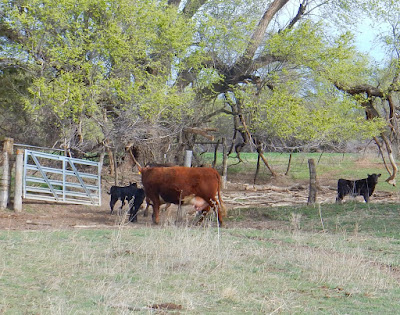Just like human moms take their children to regularly-scheduled doctor's appointments, the bovine babies go through a similar process, though we skip the weight and height measurements. And, for this particular visit, Randy serves as the "physician's assistant," without the medical degree.
There are always a few who dawdle. (There are a few in every crowd, right?) We ran the mamas and babies through a series of corrals and then into a pen by the old barn, where we sorted the pairs. I didn't get photos of that process. It's not a Kodak moment to send the mamas out, while trying to keep the babies in the pen. (In other words, I don't have any extra hands for clicking the camera shutter.)
Then, you have to convince someone to become a leader. Here, most of them were turned in the wrong direction. Guys, it works better to go head first into the barn. They eventually figured out what direction they were going. We loaded them into a trailer and hauled them to the working corrals, where each waited for his or her turn.
A few already had eartags. They were calves from heifers, which we tag as we go.
Others would get their tags while in the calf cradle, a miniature squeeze chute.
Here on the County Line, the first number on the ear tag signifies the year the calf was born. So, this year's numbers begin with a "6" for 2016. Last year's calves had a number beginning with 5 and so on. Randy's name and cell phone number are on the back for easier identification.
Each calf's left ear is notched, another form of identification we use on our farm.
Then, the baby calf and his friends get Tic-Tac-sized growth implants in their ears. Ralgrow is a hormone that stimulates the pituitary gland and helps the calf grow.
The $1 implant will bring a $3 return. Randy believes it's a matter of using the technology available to more efficiently grow food for consumers. And, yes, we eat the meat that we produce here on the farm and share it with our children and grandchildren.
We give each calf two injections. One is Ultrabac 7, an immunization to prevent blackleg. The other is Bovi-Shield Gold 5, which prevents viral diseases in cattle. People often question the reasons for giving immunizations to animals that will eventually enter the food chain. But these injections are like giving immunizations to our own children. It helps keep the calves healthy, and healthy cattle provide a good source of protein in the human diet
The bull calves, like Number 635, also become steers during their time in the chute. (The next three photos below were taken a different year, but are better than those I took yesterday.)
 Randy makes an incision in the sac.
Randy makes an incision in the sac. He pulls the testicles through the incision.
He pulls the testicles through the incision. And then he cuts the cords. It was time for No. 635 to exit the chute to make room for the next one and to join his buddies.
And then he cuts the cords. It was time for No. 635 to exit the chute to make room for the next one and to join his buddies.Here is the one we were looking for all morning - the last one of the day - the 27th.
The moms were waiting anxiously as we returned to their corral.
Cue the music: "Reunited, and it feels so good!"
It was time for a snack break.
 We sent them back to a nearby pasture to await their transport to greener summer pastures in May.
We sent them back to a nearby pasture to await their transport to greener summer pastures in May. Today on the agenda? Working another group of County Line calves. It's supposed to be windy today, so it may not be the most pleasant of working conditions.
















Such sweet baby faces! They are so resilient...all it seems to take to get over the vaccinating, ear tagging and castrating is snack time with Mom! I'm sure the music was at full volume 'til you were done! :)
ReplyDeleteIt's always fun to watch the reunion!
DeleteJust loving being able to 'return' to the farm, through your blog.
ReplyDeleteThank you, Helen. I'm always glad to have you "visit."
DeleteRoutine hormones is not so common in Australia. Actually... come to think of it I can't actually think of any beef producers that I know that use them. I really enjoy your post Kim, as it is fascinating seeing the differences between our production systems... and also many similarities.
ReplyDeleteNot everyone uses them. Randy chooses to do so. We only give them this one time when they are babies. It is long out of their systems by the time they are sold.
Delete